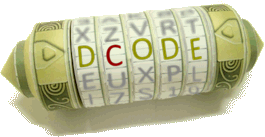Tool for Nth Derivative calculation f^(n), so 1,2,3 or n times the application of the derivation to a function, a n-tuple iterated/successive derivation on the same variable.
Nth Derivative - dCode
Tag(s) : Functions
dCode is free and its tools are a valuable help in games, maths, geocaching, puzzles and problems to solve every day!
A suggestion ? a feedback ? a bug ? an idea ? Write to dCode!
Nth Derivative
Nth Derivative Calculator
Answers to Questions (FAQ)
How to calculate a nth derivative?
The nth derivative (or derivative of order $ n $) of a function $ f $ consists of the application of the derivative iteratively $ n $ times on the function $ f $.
Example: $$ f(x) = x^4+\cos(x) \\ \Rightarrow f´(x) = 4 x^3-\sin(x) \\ \Rightarrow f´´(x) = 12x^2-\cos(x) \\ \Rightarrow f´´´(x) = 24x+\sin(x) \\ \Rightarrow f´´´´(x) = 24+\cos(x) $$
What can be a nth derivative for?
In physics, derivatives are useful for describing systems, the first derivative of a trajectory with respect to time represents speed, the second derivative represents acceleration and the third derivative characterizes jerk.
How to write a nth derivative?
An nth derivative can be written either $ f^{(n)}(x) $ or $ \frac{d^n f}{dx^n} $.
When $ n $ is small (and is 1, 2 or 3), it is common to write a prime (an apostrophe) f' for the derivative, f' ' for the second derivative, f ' ' ' for the third derivative, etc.
Which functions have remarkable successive derivatives?
The trigonometric functions $ \sin $ and $ \cos $ have successive periodic derivatives.
$$ f^{(4n)}(x) = \cos(x) \\ f^{(4n + 1)} (x) = -\sin (x) \\ f^{(4n + 2)} (x) = -\cos (x) \\ f^{(4n + 3)} (x) = \sin (x) $$
$$ f^{(4n)}(x) = \sin(x) \\ f^{(4n + 1)} (x) = \cos (x) \\ f^{(4n + 2)} (x) = -\sin (x) \\ f^{(4n + 3)} (x) = -\cos (x) $$
Source code
dCode retains ownership of the "Nth Derivative" source code. Any algorithm for the "Nth Derivative" algorithm, applet or snippet or script (converter, solver, encryption / decryption, encoding / decoding, ciphering / deciphering, breaker, translator), or any "Nth Derivative" functions (calculate, convert, solve, decrypt / encrypt, decipher / cipher, decode / encode, translate) written in any informatic language (Python, Java, PHP, C#, Javascript, Matlab, etc.) or any database download or API access for "Nth Derivative" or any other element are not public (except explicit open source licence). Same with the download for offline use on PC, mobile, tablet, iPhone or Android app.
Reminder: dCode is an educational and teaching resource, accessible online for free and for everyone.
Cite dCode
The content of the page "Nth Derivative" and its results may be freely copied and reused, including for commercial purposes, provided that dCode.fr is cited as the source (Creative Commons CC-BY free distribution license).
Exporting the results is free and can be done simply by clicking on the export icons ⤓ (.csv or .txt format) or ⧉ (copy and paste).
To cite dCode.fr on another website, use the link:
In a scientific article or book, the recommended bibliographic citation is: Nth Derivative on dCode.fr [online website], retrieved on 2025-12-23,
